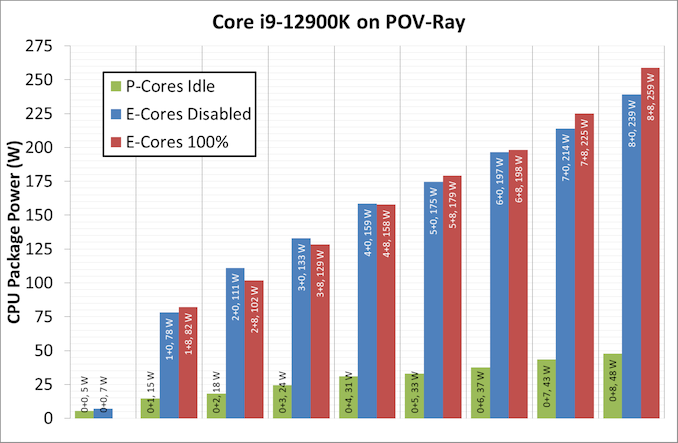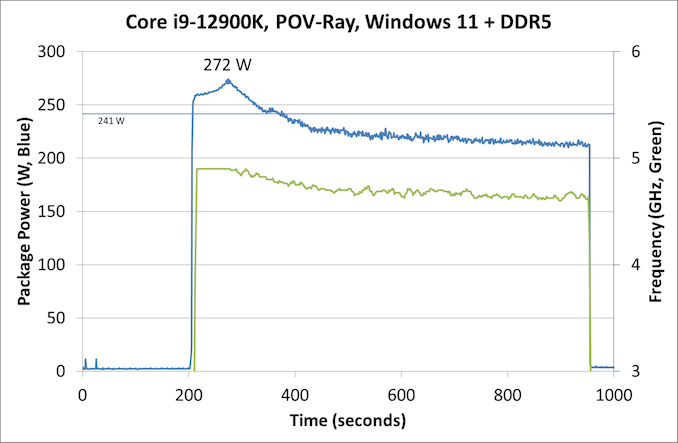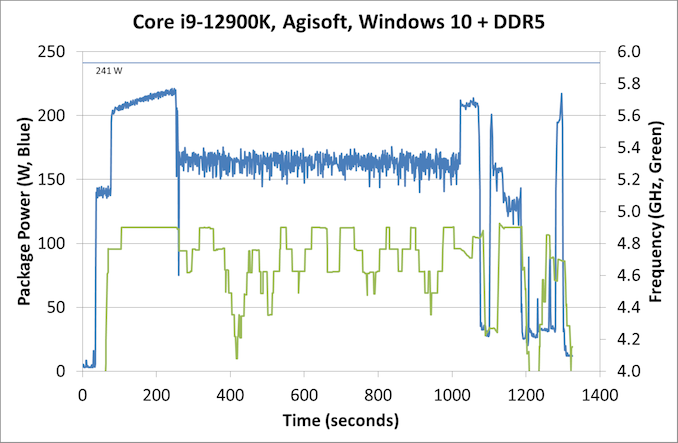The Intel 12th Gen Core i9-12900K Review: Hybrid Performance Brings Hybrid Complexity
by Dr. Ian Cutress & Andrei Frumusanu on November 4, 2021 9:00 AM ESTPower: P-Core vs E-Core, Win10 vs Win11
For Alder Lake, Intel brings two new things into the mix when we start talking about power.
First is what we’ve already talked about, the new P-core and E-core, each with different levels of performance per watt and targeted at different sorts of workloads. While the P-cores are expected to mimic previous generations of Intel processors, the E-cores should offer an interesting look into how low power operation might work on these systems and in future mobile systems.
The second element is how Intel is describing power. Rather than simply quote a ‘TDP’, or Thermal Design Power, Intel has decided (with much rejoicing) to start putting two numbers next to each processor, one for the base processor power and one for maximum turbo processor power, which we’ll call Base and Turbo. The idea is that the Base power mimics the TDP value we had before – it’s the power at which the all-core base frequency is guaranteed to. The Turbo power indicates the highest power level that should be observed in normal power virus (usually defined as something causing 90-95% of the CPU to continually switch) situation. There is usually a weighted time factor that limits how long a processor can remain in its Turbo state for slowly reeling back, but for the K processors Intel has made that time factor effectively infinite – with the right cooling, these processors should be able to use their Turbo power all day, all week, and all year.
So with that in mind, let’s start simply looking at the individual P-cores and E-cores.
Listed in red, in this test, all 8P+8E cores fully loaded (on DDR5), we get a CPU package power of 259 W. The progression from idle to load is steady, although there is a big jump from idle to single core. When one core is loaded, we go from 7 W to 78 W, which is a big 71 W jump. Because this is package power (the output for core power had some issues), this does include firing up the ring, the L3 cache, and the DRAM controller, but even if that makes 20% of the difference, we’re still looking at ~55-60 W enabled for a single core. By comparison, for our single thread SPEC power testing on Linux, we see a more modest 25-30W per core, which we put down to POV-Ray’s instruction density.
By contrast, in green, the E-cores only jump from 5 W to 15 W when a single core is active, and that is the same number as we see on SPEC power testing. Using all the E-cores, at 3.9 GHz, brings the package power up to 48 W total.
It is worth noting that there are differences between the blue bars (P-cores only) and the red bars (all cores, with E-cores loaded all the time), and that sometimes the blue bar consumes more power than the red bar. Our blue bar tests were done with E-cores disabled in the BIOS, which means that there might be more leeway in balancing a workload across a smaller number of cores, allowing for higher power. However as everything ramps up, the advantage swings the other way it seems. It’s a bit odd to see this behavior.
Moving on to individual testing, and here’s a look at a power trace of POV-Ray in Windows 11:
Here we’re seeing a higher spike in power, up to 272 W now, with the system at 4.9 GHz all-core. Interestingly enough, we see a decrease of power through the 241 W Turbo Power limit, and it settles around 225 W, with the reported frequency actually dropping to between 4.7-4.8 GHz instead. Technically this all-core is meant to take into account some of the E-cores, so this might be a case of the workload distributing itself and finding the best performance/power point when it comes to instruction mix, cache mix, and IO requirements. However, it takes a good 3-5 minutes to get there, if that’s the case.
Intrigued by this, I looked at how some of our other tests did between different operating systems. Enter Agisoft:
Between Windows 10 and Windows 11, the traces look near identical. The actual run time was 5 seconds faster on Windows 11 out of 20 minutes, so 0.4% faster, which we would consider run-to-run variation. The peaks and spikes look barely higher in Windows 11, and the frequency trace in Windows 11 looks a little more consistent, but overall they’re practically the same.
For our usual power graphs, we get something like this, and we’ll also add in the AVX-512 numbers from that page:

Compared to Intel’s previous 11th Generation Processor, the Alder Lake Core i9 uses more power during AVX2, but is actually lower in AVX-512. The difficulty of presenting this graph in the future is based on those E-cores; they're more efficient, and as you’ll see in the results later. Even on AVX-512, Alder Lake pulls out a performance lead using 50 W fewer than 11th Gen.
When we compare it to AMD however, with that 142 W PPT limit that AMD has, Intel is often trailing at a 20-70 W deficit when we’re looking at full load efficiency. That being said, Intel is likely going to argue that in mixed workloads, such as two software programs running where something is on the E-cores, it wants to be the more efficient design.














474 Comments
View All Comments
Netmsm - Monday, November 8, 2021 - link
@Wrs Assume we give you this, just drop AMD related things.Let's focus on performance per watt of new Intel Architecture. I asked some questions about this which is a pertinent topic to this article but you dodged. Just talk about 241 watt being sucked by 12900k :))
ajollylife - Sunday, November 7, 2021 - link
To be fair Intel's def not perfect. The i225v lan bug comes to mindDominionSeraph - Saturday, November 6, 2021 - link
When Intel doesn't have this issue it is AMD.Intel demands validation and spends hundreds of millions on engineers to help motherboard manufacturers fix their issues before release because they realize that the motherboard is an INSEPERABLE part of the equation. You can fanboi all you want over the CPU, but if there are no good motherboards you have a terrible system.
AMD just dumps their chip on the market, leaving the end-user with a minefield of motherboard issues among every manufacturer.
When Intel has the problem solved but AMD doesn't, it's an AMD issue.
Qasar - Saturday, November 6, 2021 - link
DominionSeraph have you tried this on a different x570 board ? it COULD be just that board, as was already stated. i have been running a 5900x now for about a week, and no issues at all with disk access, its the same as the 3900x i replaced, and im using an asus x570 e-gaming board.maybe take a step back, realize that its NOT an amd issue, but a BOARD issue. to be fair, intel has had its own issues over the years as well, while you see them as perfect, sorry to break it to you, but intel also isnt perfect
Netmsm - Sunday, November 7, 2021 - link
Oh I got it, the fact that you're encountering unusual issues, despite myriads of people who haven't complained of the same problem you have, means that AMD got many incompatibility issues.That's a brilliant reasoning which brings us to a pure conclusion: AMD is bad. We're done here.
Dug - Monday, November 15, 2021 - link
@DominionSeraph"Note Intel doesn't allow "dog sh1t motherboards" to happen, especially at the $300+ price point. That makes it an AMD issue."
You obviously haven't looked at or experienced the issues that plague many motherboards. Maybe just read some reviews or visit manufactures forums to get an idea of how bad it is before making such a naïve statement.
It has more to do with the manufacturer of the board than the CPU.
That is like saying nvidia doesn't make crap video cards. Well you need to look at all the failures by each manufacturer, not nvidia itself.
madseven7 - Saturday, November 6, 2021 - link
You put that chip in an ASROCK motherboard. That's the reason for the issues.xhris4747 - Tuesday, November 9, 2021 - link
Lol 😅FLORIDAMAN85 - Friday, November 12, 2021 - link
I, too, have made the error of purchasing an ASRock board.mode_13h - Saturday, November 13, 2021 - link
So far, my ASRock Rack server board is still going strong.